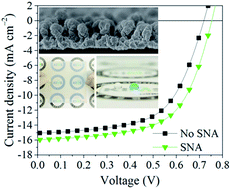当前位置:
X-MOL 学术
›
J. Mater. Chem. A
›
论文详情
Our official English website, www.x-mol.net, welcomes your feedback! (Note: you will need to create a separate account there.)
Simultaneous improvements in self-cleaning and light-trapping abilities of polymer substrates for flexible organic solar cells†
Journal of Materials Chemistry A ( IF 11.9 ) Pub Date : 2018-01-19 00:00:00 , DOI: 10.1039/c7ta09351a Eunwook Jeong 1, 2, 3, 4, 5 , Guoquing Zhao 1, 2, 3, 4 , Myungkwan Song 1, 2, 3, 4 , Seung Min Yu 4, 6, 7, 8 , Jongjoo Rha 1, 2, 3, 4 , Jongmoon Shin 1, 2, 3, 4 , Young-Rae Cho 4, 5, 9, 10 , Jungheum Yun 1, 2, 3, 4
Journal of Materials Chemistry A ( IF 11.9 ) Pub Date : 2018-01-19 00:00:00 , DOI: 10.1039/c7ta09351a Eunwook Jeong 1, 2, 3, 4, 5 , Guoquing Zhao 1, 2, 3, 4 , Myungkwan Song 1, 2, 3, 4 , Seung Min Yu 4, 6, 7, 8 , Jongjoo Rha 1, 2, 3, 4 , Jongmoon Shin 1, 2, 3, 4 , Young-Rae Cho 4, 5, 9, 10 , Jungheum Yun 1, 2, 3, 4
Affiliation

|
Organic solar cells (OSCs) supported on mechanically flexible and optically transparent polymer substrates have been receiving increased attention owing to their noticeable merits of low cost, light weight, and flexible design that are unattainable by their existing counterparts supported on rigid glass substrates. However, technical issues such as relatively low photon-to-electron conversion efficiencies and long-term stabilities of OSCs on polymer substrates require the enhancement and maintenance of the efficiency of OSCs. In this study, a simple, direct vacuum deposition strategy was used to fabricate a multifunctional silica nanoparticle array (SNA) layer on polymer substrates for improving and maintaining the light harvesting efficiencies of OSCs; this induces simultaneous and significant enhancements in the light-scattering and contaminant-repelling (or self-cleaning) properties of the substrate. The SNA layer led to improved light scattering features, representing haze transmittances ranging from 3.4% to 80.4% in the visible spectral range with strong influences of its geometrical features on the hydrophobic/oleophobic characteristics of the substrate. Any contaminant-induced reduction in the performance of OSCs could be successfully prevented by the strong contaminant-repelling feature, characterized by high contact angles (>150°) and low sliding angles (<15°) for water and ethylene glycol, without compromising the optical transparency of the polymer substrate. A combination of the SNA layer and oxide/metal/oxide (OMO) electrode coating on each side of the polymer substrate provides a promising solution to improve the performance of OSCs. The power conversion efficiency was enhanced by 13.31% compared to that of an OSC based on the same polymer substrate without the SNA layer.
中文翻译:

同时提高了用于柔性有机太阳能电池的聚合物基板的自清洁和俘获光的能力†
支撑在机械柔性和光学透明聚合物基板上的有机太阳能电池(OSC)由于其低成本,轻巧和设计灵活的显着优点而受到越来越多的关注,而这些优点是它们现有的支撑在刚性玻璃基板上的同类产品无法实现的。然而,诸如相对低的光子-电子转换效率和聚合物基板上的OSC的长期稳定性之类的技术问题要求OSC的效率的提高和维持。在这项研究中,使用一种简单,直接的真空沉积策略在聚合物基底上制备多功能二氧化硅纳米粒子阵列(SNA)层,以提高和保持OSC的光收集效率。这会同时显着增强基材的光散射和排斥污染物(或自清洁)性能。SNA层改善了光散射特性,在可见光谱范围内雾度透射率范围从3.4%到80.4%,并且其几何特性对基材的疏水/疏油特性有很大影响。强大的污染物排斥功能可成功防止任何污染物引起的OSC性能下降,其特征是与水和乙二醇的接触角大(> 150°)和滑动角小(<15°),而不会损害聚合物基材的光学透明性。SNA层和聚合物基材每一面上的氧化物/金属/氧化物(OMO)电极涂层的结合提供了一种有希望的解决方案,可改善OSC的性能。与基于没有SNA层的相同聚合物基板的OSC相比,功率转换效率提高了13.31%。
更新日期:2018-01-19
中文翻译:

同时提高了用于柔性有机太阳能电池的聚合物基板的自清洁和俘获光的能力†
支撑在机械柔性和光学透明聚合物基板上的有机太阳能电池(OSC)由于其低成本,轻巧和设计灵活的显着优点而受到越来越多的关注,而这些优点是它们现有的支撑在刚性玻璃基板上的同类产品无法实现的。然而,诸如相对低的光子-电子转换效率和聚合物基板上的OSC的长期稳定性之类的技术问题要求OSC的效率的提高和维持。在这项研究中,使用一种简单,直接的真空沉积策略在聚合物基底上制备多功能二氧化硅纳米粒子阵列(SNA)层,以提高和保持OSC的光收集效率。这会同时显着增强基材的光散射和排斥污染物(或自清洁)性能。SNA层改善了光散射特性,在可见光谱范围内雾度透射率范围从3.4%到80.4%,并且其几何特性对基材的疏水/疏油特性有很大影响。强大的污染物排斥功能可成功防止任何污染物引起的OSC性能下降,其特征是与水和乙二醇的接触角大(> 150°)和滑动角小(<15°),而不会损害聚合物基材的光学透明性。SNA层和聚合物基材每一面上的氧化物/金属/氧化物(OMO)电极涂层的结合提供了一种有希望的解决方案,可改善OSC的性能。与基于没有SNA层的相同聚合物基板的OSC相比,功率转换效率提高了13.31%。



























 京公网安备 11010802027423号
京公网安备 11010802027423号